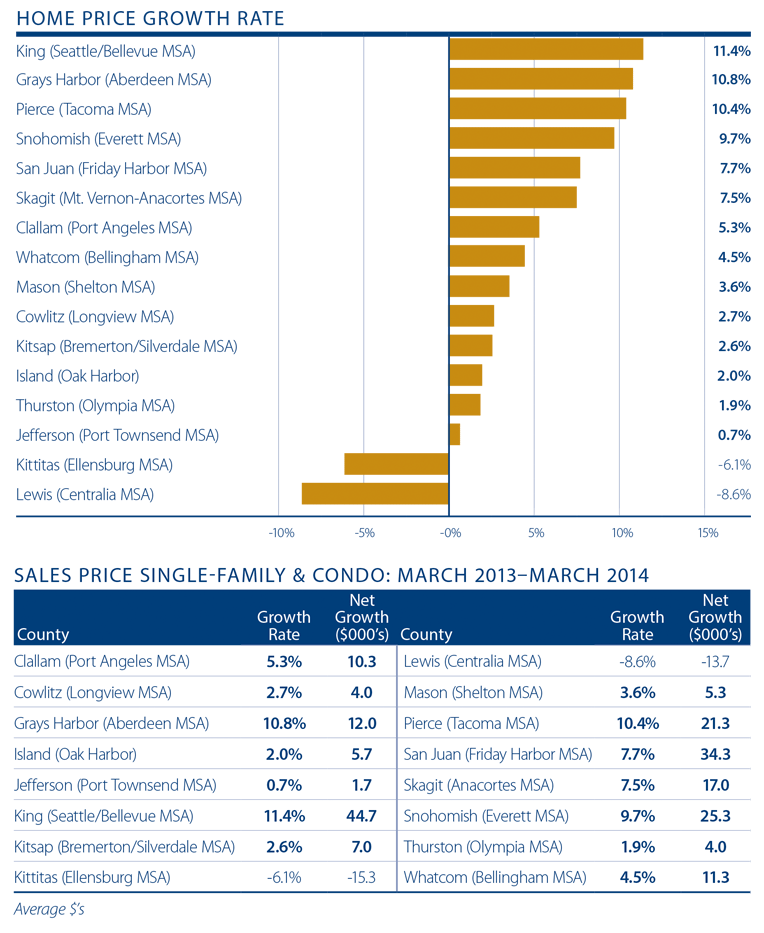Windermere Real Estate is proud to partner with Gardner Economics on this analysis of the Western Washington real estate market. This report is designed to offer insight into the realities of the housing market. Numbers alone do not always give an accurate picture of local economic conditions; therefore our goal is to provide an explanation of what the statistics mean and how they impact the Western Washington housing economy. We hope that this information may assist you with making an informed real estate decision. For further information about the real estate market in your area, please contact your Windermere agent.
Regional Economics
With the first quarter of 2014 now in the rear view mirror, I think that it is fair to say that our state as a whole, and specifically the counties covered within this report, continue to improve from an economic perspective.
Washington State added just shy of 61,000 jobs over the past 12-month period, an annualized growth rate of 2.1 percent, while the markets covered by our report added 50,690 jobs (a 2.3 percent increase over a year ago).
This annual rate was modestly better than the 2.1 percent growth rate seen in our last report and, additionally, the market added 23,730 jobs during first quarter.
The tri-county areas of King, Snohomish and Pierce Counties continue to dominate in terms of employment growth with the addition of 43,700 total jobs over the past 12 months—slightly higher than the 42,800 jobs added in calendar year 2013.
On a county level, King County (+3.3%) maintains its top position relative to annualized employment growth. Somewhat surprisingly, this was matched by San Juan County (+3.3%), but in real terms this meant the addition of only 160 jobs. Rounding out the top three growth markets was Cowlitz County which added 900 jobs, a 2.5 percent annual rate. It is pleasing to see some of the southern counties starting to improve. It has been a while!
Job losses were limited to just two counties, with Jefferson County (-1.0%) and Kittitas County (-0.2%) seeing a decline in employment over the last year.
Looking at unemployment rates in the region, all but two counties saw an unemployment rate that was lower than that seen a year ago.
When compared to March of 2013, the greatest declines in the unemployment rate were in Lewis County and Cowlitz County where the rate dropped by 1.7 percent to 10.7 percent and 9.4 percent respectively. This was followed by San Juan County (6.2%) and Grays Harbor County (11.4%).
We saw the unemployment rate rise in Snohomish County which moved up from 5.7 percent to 6.0 percent, and in King County where the rate rose marginally from 5.1 percent to 5.2 percent. Although this may appear surprising, it really isn’t. The principal reason for this statistic was that the labor force in both areas grew by a substantial three percent. I’ll explain: As job markets improve, more people start to look for work. When they look for work, they are officially counted as being unemployed and, therefore, it is not a surprise to see the rate rise. In fact, this is actually good news! The current labor force in these counties was measured at 1.565 million—a figure that has never been higher. As such, I am not worried about the increase and anticipate that the rate in both these counties will start to drop again shortly.
In my last report, I suggested that in 2014 the region should add approximately 50,000 new jobs. At the current rate of 50,690, I appear to be right on track. That said, we are still not “outperforming” and, as such, I am still maintaining the “B+” grade that I have given the employment situation for the past three quarters.
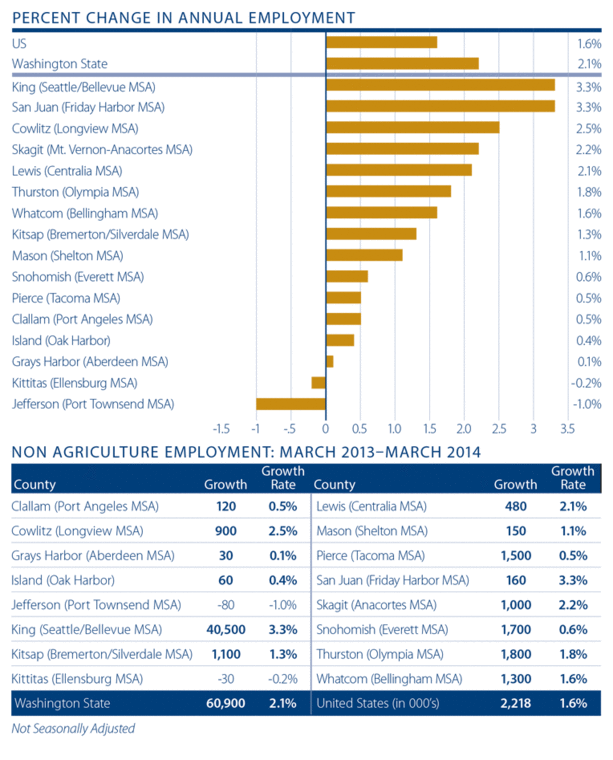
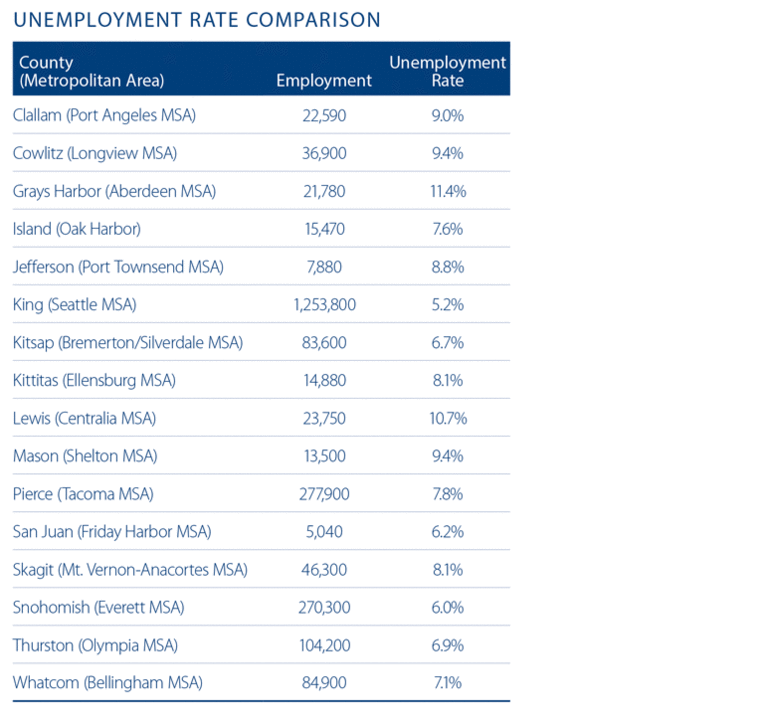
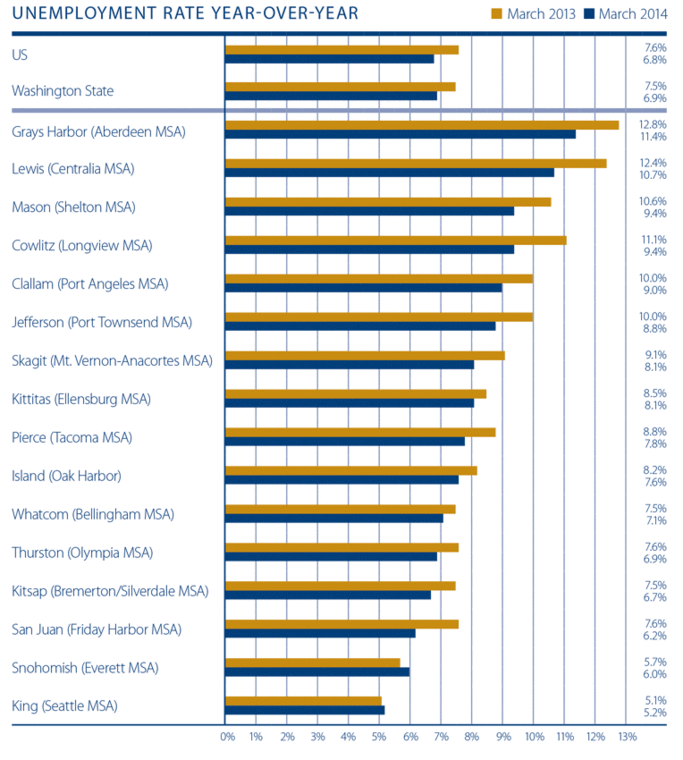
Regional Real Estate
Brokers throughout Western Washington that I have talked to this spring are, on the whole, confident that the market will continue to improve as we move through 2014, but there are some obstacles. In general, these revolve around the disappointing levels of inventory which in certain markets have led to frantic bidding wars—something that holds little appeal to anyone other than sellers.
Year-over-year, listings are generally higher than March 2013, with the market reporting a five percent rise in inventory levels. This is a good thing; however, the total number of homes for sale still remains well below historic levels. By example, total listing activity is 49 percent below that seen in March of 2009. Many, including myself, hope that this will improve in the coming months.
The greatest growth in listings was again seen in Snohomish County which saw a 35 percent increase in homes for sale. This was followed by Pierce County where total listings were 18 percent higher than a year ago, and Cowlitz County where inventory levels were 11 percent higher. Five other counties experienced single-digit increases in listings, but eight counties saw listing activity at the end of 2013 below that seen a year ago. The largest losses were seen in Skagit (-15.7%), Grays Harbor (-11%), and Mason (-10%) Counties.
Year-to-date, home sales in 2014 were 10.8 percent higher than seen in the first quarter of 2013, with a total of 14,896 sales recorded. The greatest increase in home sales was seen in Grays Harbor County (+46.6%), which would explain their lack of inventory at the present time. This was followed by Snohomish County (+37.3%), Island County (+22.3%) and Kittitas County (+20.5%). Five additional counties saw year-over-year home sales rise by 10 percent during the first quarter, while two others saw single-digit growth. All-in-all, positive momentum for home sales in Western Washington.
There were five counties where home sales fell compared to a year ago, but these declines were fairly modest. What was of particular interest, and just a little concern, was the number of home sales in the first quarter versus fourth quarter of 2013. Total sales were down by 20.2 percent, which is somewhat counterintuitive as one would expect the spring market to be better than the winter. At the present time, I am putting this down less to inventory limitations, and more to the fact that interest rates fell last quarter, which may have pulled some buyers forward who would have normally bought in the spring. Time will tell if this is an accurate hypothesis or not!
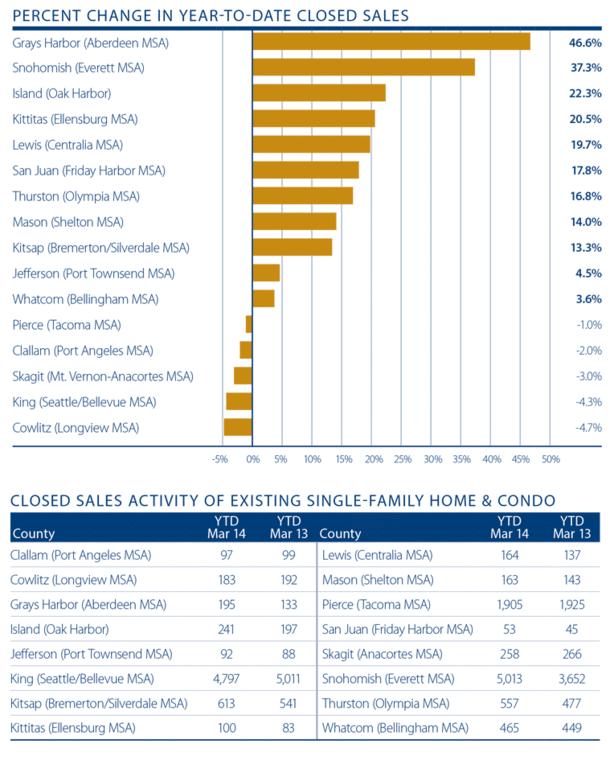
The average home price in the Western Washington region was $315,835 – up by 7.1 percent over the first quarter of 2013. As is seen in the chart to the right, all but two counties saw average sales prices rise versus those seen in the first quarter of 2013. Prices have been evening out over the past year, which is actually good news and indicates that growth rates are moving toward more sustainable levels.
When we look at individual counties, the strongest annual gains were in King County where prices rose by 11.4 percent. There were also double-digit gains seen in Grays Harbor County (+10.8%) and Pierce County (+10.4%). Of the balance, all but two saw price increases in the single digits. These modest declines were in the small Lewis County market (-8.6%) and the equally diminutive Kittitas County (-6.1%).
Compared to the fourth quarter of 2013, home prices were higher in five counties, with King County remaining at the same level. Home prices fell in ten of the counties analyzed but most of the declines were relatively modest.
Not particularly surprising was the comparison to sales prices seen two years ago. All but two counties (Thurston and Mason) showed home pricesrising. At long last, we saw a county where prices are now higher than seen five years ago, with King County home prices 9.2 percent higher than seen in the first quarter of 2009. Home prices in several other counties are now less than ten percent below that seen five years ago, and I anticipate that they will all enter positive territory before the end of the year.
It is now time to bump the grade on home prices from a “B-” to a “B”. Although home sales activity has slowed, sustained price growth is likely to be seen in 2014 assuming that numbers of listings continue to rise.
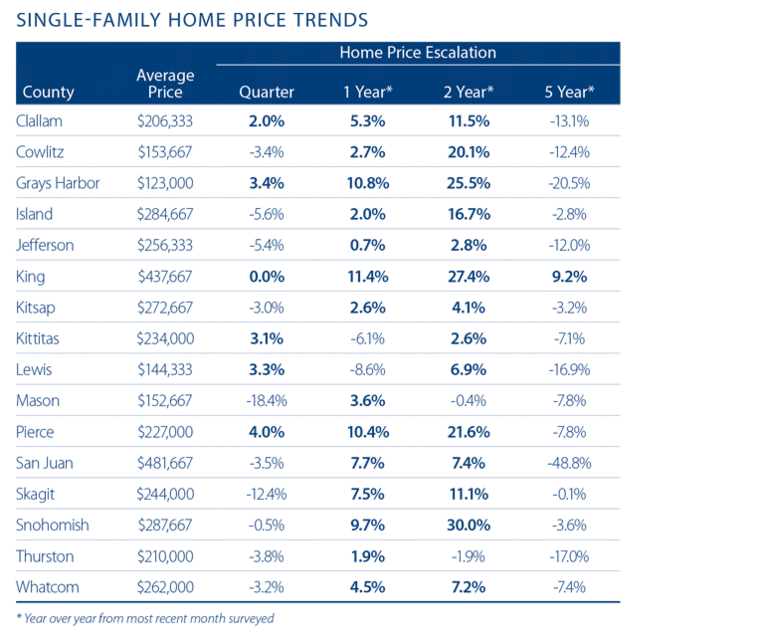
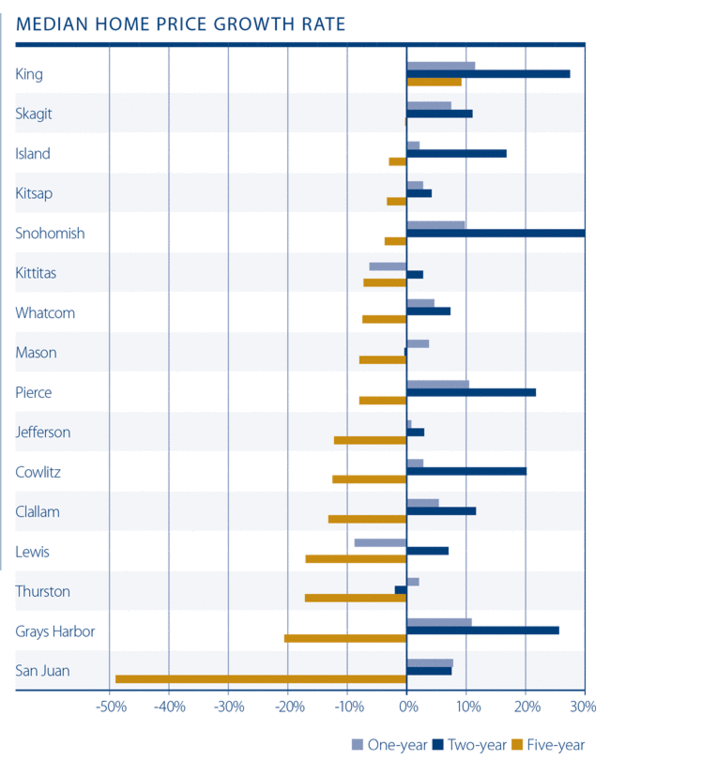
Conclusions
Some people I’ve spoken to appear to be waiting for “the other shoe to drop”; meaning that we should expect to see a decline in home values after a rather bullish market over the past two years.
For my part, I am not seeing that happen. In fact, I still believe that there is quite reasonable upside potential for home values in 2014. Why do I say this? Well, there are several reasons that suggest a relatively healthy prognosis for our region.
The first reason is that economically the region continues to add jobs. This is a critical component of the housing market. With a regional growth rate that is well above that seen in the U.S. as a whole, we are in pretty good shape. And as of yet, I do not think we are firing on all cylinders.
Secondly, the interest rate environment is still really good. Although interest rates are above the historic lows seen in 2013, they are still remarkably modest. I do expect to see rates continue to rise this year, but my forecast suggests that average 30-year fixed mortgage rates will still end 2014 at a level around five percent.
Finally, although banks have been notoriously tight in terms of qualifying potential buyers for mortgages, all indications suggest that they are starting to ease a little. Average FICO scores are slowly coming down, which will only add to potential buyers’ abilities to qualify for mortgages.
There is, however, a flip side to this argument and that is inventory-related. Although we did see a five percent increase in listings in March of 2014 compared to March of 2013, the current level is still well below where it should be. Despite that, I remain confident that we will see further growth in listing activity as we move through the year, but do not expect to see a “balanced” market in the near-term.
Belief in home ownership has returned. That being said, I anticipate that buyers will continue to outpace sellers in the coming year. This will be frustrating to some, but a benefit to others. So goes the market!
About Matthew Gardner
 Mr. Gardner is a land use economist and principal with Gardner Economics and is considered by many to be one of the foremost real estate analysts in the Pacific Northwest.
Mr. Gardner is a land use economist and principal with Gardner Economics and is considered by many to be one of the foremost real estate analysts in the Pacific Northwest.
In addition to managing his consulting practice, Mr. Gardner chairs the Board of Trustees at the Washington Center for Real Estate Research at the University of Washington; sits on the Urban Land Institutes Technical Assistance Panel; is an Advisory Board Member for the Runstad Center for Real Estate Studies at the University of Washington; and is the Editor of the Washington State University’s Central Puget Sound Real Estate Research Report.
He is also the retained economist for the Master Builders Association of King & Snohomish Counties. He has twenty-five years of professional experience in the U.K. and U.S.
He has appeared on CNN, NBC and NPR news services to discuss real estate issues, and is regularly cited in the Wall Street Journal and all local media.
 Facebook
Facebook
 X
X
 Pinterest
Pinterest
 Copy Link
Copy Link
